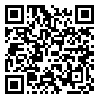Volume 8, Issue 27 (3-2002)
RJMS 2002, 8(27): 603-607 |
Back to browse issues page
Download citation:
BibTeX | RIS | EndNote | Medlars | ProCite | Reference Manager | RefWorks
Send citation to:



BibTeX | RIS | EndNote | Medlars | ProCite | Reference Manager | RefWorks
Send citation to:
Kamalipour H, Kazemi A, Hosseini F. STUDY OF COMPARISON OF DENTAL INJURIES DURING ENDOTRACHEAL INTUBATION BETWEEN STANDARD AND MODIFIED MACINTOSH LARYNGOSCOPE. RJMS 2002; 8 (27) :603-607
URL: http://rjms.iums.ac.ir/article-1-390-en.html
URL: http://rjms.iums.ac.ir/article-1-390-en.html
Abstract: (9041 Views)
ABSTRACT
The Macintosh Laryngoscope has proved itself over half a century and is still one of the most popular laryngoscopes. Even in experienced hands, however, complications can occur notably damage to the maxillary incisors. Damage to teeth is reported to be the most common single reason for complaints against anesthesiologists. Dental injuries could be caused by friction or by contact of the upper teeth with a hard blade during a rigid laryngoscopy there are three major groups of causative factors
1- unfavorable patient anatomy, 2-the skill of the laryngoscopist, 3-the designof the laryngoscope blade. Generally a combination of these factors is responsible. We modified macintosh laryngoscope for redution of dental complication when the optimum visibility of the glottis was obtained.100 elective surgical patients scheduled for general anesthesia with endotracheal intubation, were enrolled in this study. After induction, they were intubated using both the modified and standard macintosh laryngoscope. The distance between the blade and the upper central incisors was measured when the optimum visibility of the glottis was obtained. The visibility was determined according to the Cormack-Lehane grading. All laryngoscopies were performed by the same anesthesiologist. If a spo2 value decreased to less than 90% the measurment of the blade-tooth distance was to be interrupted temporarily while the patients was further ventilatd with 02 100%.
Visibility in standard blade were, grade 1=84%, grade 2=11%, grade 3=5% and grade 4=0, and for modified blade were, grade1=38%, grade 2=44%, grade 3=18% and grade 4=0. The first intubation attempt was successful in 72pt (72%) of the modified blade group and in all patients of the standard blade group. The modification resulted in reduction of the forces and damage on the teeth but increased of the laryngoscopic view, also, the modification resulted in reduction of the success of intubation. These results suggest that laryngoscope blade with low proximal step, might be less traumatic than blade in which proximal step is high.
Keywords: 1) Moified macintosh laryngoscope 2) Tooth injary 3) Complication of Endotracheal intubation
Type of Study: Research |
Subject:
Anesthesiology
| Rights and permissions | |
 |
This work is licensed under a Creative Commons Attribution-NonCommercial 4.0 International License. |





